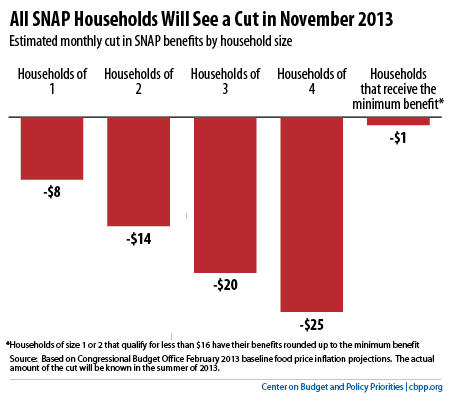BEYOND THE NUMBERS
While Washington has finished focusing on the “fiscal cliff,” low-income individuals and families who participate in the Supplemental Nutrition Assistance Program (SNAP, formerly known as Food Stamps) may be more focused on the “food cliff” — the scheduled SNAP benefit cut that will occur November 1 when the 2009 Recovery Act’s temporary benefit boost ends, as we explain in a new paper. Benefits will fall for every SNAP household, and the Congressional Budget Office estimates that for a family of three, the cut likely will be $20 to $25 a month — or $240 to $300 over 12 months.

That’s a serious loss, especially in light of the already very low basic SNAP benefits. Without the Recovery Act’s boost, SNAP benefits average only about $1.30 per person per meal. Nutrition experts have long held that these levels are inadequate to meet families’ basic food needs.
The Recovery Act increased SNAP benefits beginning in April 2009, which has helped to spur economic activity and assist low-income households during the Great Recession. The Recovery Act called for benefits to remain at their new, higher level until the program’s regular annual inflation adjustments surpassed it. In 2010, however, Congress passed legislation ending the increase abruptly on November 1, 2013.
These cuts will likely cause hardship for some SNAP participants, who include 22 million children (10 million of whom live in “deep poverty,” with family incomes below half of the poverty line) and over 9 million people who are elderly or have a serious disability.
U.S. Department of Agriculture (USDA) research has found that the Recovery Act’s benefit boost cut the number of households in which one or more persons had to skip meals or otherwise eat less because they lacked money — what USDA calls “very low food security” — by about 500,000 households in 2009.
More recent research finds that boosting SNAP benefits during the summer for households with school-aged children who don’t have access to USDA’s summer food program cut very low food security among these households by nearly 20 percent.
Given the hardship that these cuts will likely cause, we don’t want to see benefits fall this November. And, as Congress contemplates more deficit cutting, any further SNAP cuts should be off the table.
Click here to read the full paper.
